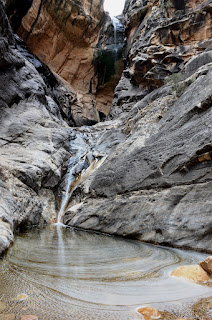Hiked Saturday, December 31. Yes, last hike of the year. ;D And only half as many as last year. But I had a good excuse!
The last "hike" was actually three separate hikes: Lost Canyon waterfall (2/3 of a mile, roundtrip), Icebox Canyon waterfalls (2.2 miles, roundtrip), and First Creek waterfall (2.2 miles roundtrip).
Lost Canyon trailhead is off of Rocky Gap Road. You have to take the big, looping scenic drive just about halfway around. Rocky Gap is the second road after you've passed the scenic view at the top of the loop. Once on Rocky Gap Road, the first parking area on the left is the one for Lost Canyon (and the Children's Discovery trail). For Lost Canyon, take the trail that heads from the middle of the ends of the parking area.
You'll soon be treated to the view of the first photo in this post (looking to your right). There's a (usually) dry wash crossing, then a slight incline, then some boardwalk as you walk among the spring.
After that, you continue your climb, and soon reach the end of the canyon, with the waterfall, above. It's a fairly large drop, as you can see, and the often-slight waterflow sometimes seems to dissipate as it descends. Walk under the falls, and it will look something like the third photo in this shot.
No idea who the hikers in the photos are, by the way. But, on this day, the trail was busy enough that waiting for a chance at an un-modeled shot would take too long. Also, the other hikers give a sense of scale to this waterfall.
I'd been to Lost Canyon twice before in recent years,
once when it was mostly dry, and once,
during active rain, when it was flowing.
Next on my agenda was Icebox Canyon. I had also hiked here at least twice before in recent years, and also, once when it was mostly dry, and once when it was actively raining. Pictures from both times are in
this post, from 2013.
Icebox Canyon is the next parking area along the scenic drive down from Rocky Gap. Fun thing about this hike was my parking spot: I literally got the first spot, right at the trailhead. Yes, little things can feel like wins, especially when you're visiting Las Vegas.
The first part of this hike is largely level. Yes, there's an incline. But it's easy going. You soon cross a connector trail (last time here, I walked that connector, down from Lost Canyon). But I had the goal of multiple waterfalls, and didn't want to tire myself out with the extra two miles roundtrip from Lost Canyon.
As the trail proceeds and the canyon narrows, you soon find yourself overlooking the sound and sight of running water, down on your left. You should resist the urge to drop down into that canyon until the last possible moment, since the trail (and the going) is a lot easier up top than it is down below.
Nonetheless, you will soon find yourself with no choice but to descend, then boulder hop, and find your way among the boulders and undergrowth of Icebox Canyon. On this part, the thing to remember is that there are almost always multiple ways past each obstacle. If you find your way appearing too daunting, step back and look for an alternate route. Yes, if the water is high, you may have your choices limited. But, usually, there's an easily manageable way around each barrier.
This includes the "final" barrier, to the base of the lower waterfall. In this case, head to the left, and climb up behind the tree that shields you from a possible fall as you climb the few feet up to the next level.
Getting up to the next level is a little scarier, if only because it's unprotected. I've climbed there before, but chickened out, this time. There's also a middle fall (invisible from the photo, above). Then, getting beyond that fall to the next pool is even more daunting, and I did not attempt that, last time.
Returned to my car, and completed the scenic loop. Then I turned right, towards First Canyon. I had never been here, before. It appeared to be about the third trail access point west from the loop. It also had a big sign that said, "First Creek," at the wide area on the side of the highway. The other two spots I had stopped did not have signs on my eastbound approach. I think the Oak Creek trailhead, at least, should normally be signed, but it appears stupid people make a habit of vandalizing signs out here.

For this hike, I followed the directions of the "bird and hike" website (you can find it, with an easy search). The general idea is to stay on the main and obvious trail until you reach some pine trees. As you approach the first of these pine trees (on your right side), that's where you need to leave the main trail for an unsigned use trail that drops to the base of this small (10-12 feet, at most) falls. On the day I hiked, there was weird graffiti and an arrow on a rock (second from last photo) that pointed along the main trail. A very clear but also "incorrect" trail went straight where the main trail turned right. I went on the "wrong" trail, and found myself at the top of the falls. Backtracking, a bit, I found a conglomerate rock (third picture from the last). Sticking hard to the left as I descended, I found a narrow but easy way to the base of the falls.
Three falls (four, if you count two at Icebox Canyon) and about five miles for the day. Not a bad end to my year.





























